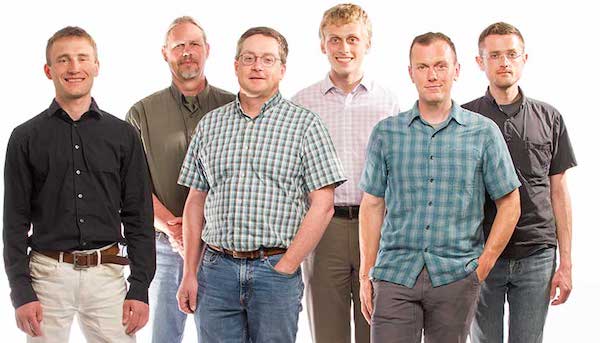
[Image above] NREL’s HTEM Database group (from left) Andriy Zakutayev, Robert White, John Perkins, Marcus Schwarting, Caleb Phillips, and Nick Wunder. Credit: Dennis Schroeder; NREL
Scientists and researchers spend a lot of time conducting experiments, many of which are trial and error. Usually it takes multiple experiments involving several processes and methods using multiple sample sizes and variables to solve a problem. And depending on the scope of the research, it can take days, weeks, months, or even years to reach a breakthrough.
New research is usually built upon the successes of previous research. Some research requires the use of expensive equipment, which some researchers—by virtue of their employer’s budget, or lack thereof—may not have access to.
Access to technical data on research that has already been tested and proven can enable more collaboration, save time, and speed up the progress of scientific research overall.
Fortunately, several forward-thinking scientists at the National Renewable Energy Laboratory (NREL) have also thought about this. In a collaboration led by scientist Andriy Zakutayev at NREL’s Materials Science Center and data scientist Caleb Phillips at NREL’s Computational Science Center, an NREL team created a database accessible to researchers studying inorganic materials for advanced energy applications.
The High Throughput Experimental Materials (HTEM) database is a collection of more than 140,000 sample entries of data on inorganic thin-film materials for advanced energy research. The entries offer “details about the structural, chemical, and optoelectronic properties of the materials, and their synthesis conditions,” according to an NREL news release.
The team curated data from 10 years of experiments in inorganic thin-film materials at NREL. The database is digitized and searchable to users.
“All existing experimental databases either contain many entries or have all this property information, but not both,” Zakutayev says in the release.
When writing papers for publication, researchers often only mention their successes. But what about the failures? How many different samples did they try before succeeding with the final material? Knowing the outcomes of experimental failures could save time in unnecessary research for others who are working on the same or similar problems.
The database’s mission, stated on the opening page of the HTEM database, is “to enable discovery of new materials with useful properties by releasing large amounts of high-quality experimental data to public.”
And that also means accessibility to all materials science researchers. “Our belief is that putting all this data out in the public domain would accelerate the advancement of material science, in particular by researchers without access to expensive experimental equipment, both in the United States and around the world,” Materials Science Center senior scientist and team member John Perkins explains in the news release.
The research team is now focused on collaborating with the National Institute of Standards and Technology on a larger project—the High-Throughput Experimental Materials Collaboratory—to create a network of experimental tools that researchers could essentially collaborate on synthesizing and analyzing new materials and share their results in the database.
The open-access paper, published in Scientific Data, is “An open experimental database for exploring inorganic materials” (DOI: 10.1038/sdata.2018.53).
Want to read more articles like this? Subscribe to the Ceramic Tech Today newsletter to continue to receive the latest news in the ceramic and glass industry right in your inbox! Visit this link to get started.
